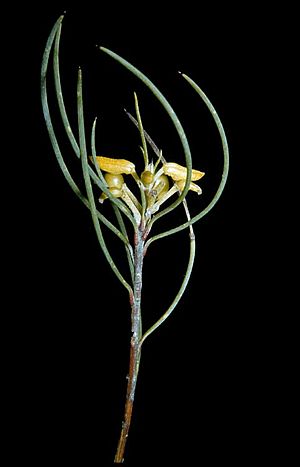Persoonia saundersiana facts for kids
Quick facts for kids Persoonia saundersiana |
|
|---|---|
 |
|
| Scientific classification | |
| Genus: |
Persoonia
|
| Species: |
saundersiana
|
| Synonyms | |
|
|
Persoonia saundersiana is a special type of flowering plant. It belongs to the Proteaceae family, which includes many unique Australian plants. This shrub is found only in the south-west part of Western Australia. It grows upright or spreads out, with young branches that feel a bit fuzzy. It has long, thin leaves and bright yellow flowers. These flowers grow in groups of up to twenty-five on a stem called a rachis, which can be up to 100 millimeters (about 4 inches) long. What's cool is that this stem keeps growing even after the flowers have bloomed!
What it Looks Like
Persoonia saundersiana is a shrub that usually grows between 0.5 and 5 meters (about 1.5 to 16 feet) tall. Its bark is smooth, but near the bottom, it can be rough and peel off. The young branches are covered with soft, greyish hairs.
The leaves are long and narrow. They measure about 40 to 210 millimeters (1.5 to 8 inches) long and 1 to 3.2 millimeters (0.04 to 0.13 inches) wide. They often curve upwards.
The bright yellow flowers grow in groups of up to twenty-five. They are arranged along a stem part called a rachis, which can be up to 100 millimeters (4 inches) long. This rachis keeps growing even after the flowers have bloomed. Each flower sits on a hairy stalk called a pedicel, which is 3.5 to 20 millimeters (0.14 to 0.79 inches) long. At the base of each flower's stalk, there's a leaf or a small scale-like leaf.
The flower parts, called tepals, are bright yellow and measure 9.5 to 14 millimeters (0.37 to 0.55 inches) long. The side tepals are clearly uneven in shape, and the lower tepal looks like a small sac. This plant mostly flowers from September to November. After flowering, it produces a smooth, oval-shaped fruit called a drupe. This fruit is 7 to 11 millimeters (0.28 to 0.43 inches) long and 5 to 7.5 millimeters (0.20 to 0.30 inches) wide.
Plant History and Naming
The plant Persoonia saundersiana was first officially described in 1855. This description was made by Carl Meissner in a scientific journal called Hooker's Journal of Botany and Kew Garden Miscellany. He used plant samples collected by James Drummond to make his description.
Where it Grows
This type of geebung plant grows in scrubland and a type of bushland called mallee heath. You can find it in the area between Minnivale, Tammin, Lake Hope, and Comet Vale. These places are located in several different biogeographic regions in the south-west of Western Australia. These regions include the Avon Wheatbelt, Coolgardie, Geraldton Sandplains, Mallee, Murchison, and Yalgoo.
Conservation Status
The Government of Western Australia's Department of Parks and Wildlife has classified Persoonia saundersiana as "not threatened." This means that, for now, there are enough of these plants in the wild, and they are not considered to be at risk of disappearing.

